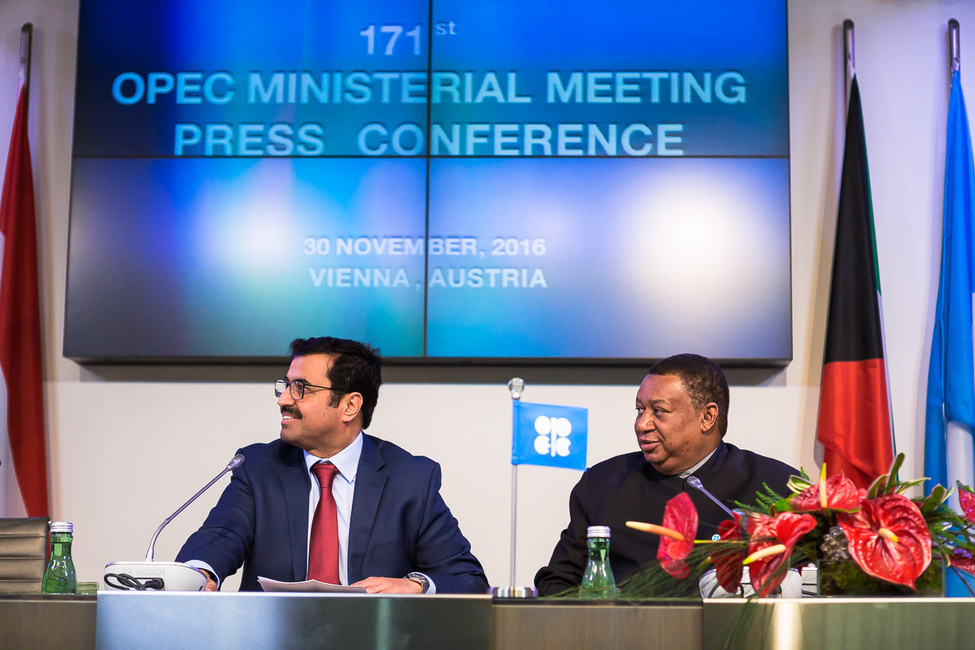
OPEC cut output by 840,000 barrels a day last month, but has more work to do to fully comply with last year’s historic production deal.
The Organization of Petroleum Exporting Countries pumped 32.3 million barrels a day in January, according to a Bloomberg News survey of analysts, oil companies and ship-tracking data. The 10 members of the group that pledged to make cuts in Vienna two months ago implemented 83 percent of those reductions on average, but their efforts were offset by increases from Iran, Nigeria and Libya that were permitted under the terms of the agreement.
Accounting for the members who raised output and the suspension of Indonesia, OPEC’s total output remains 550,000 barrels a day above the target set out in the Nov. 30 deal. That means the group as a whole is only about 60 percent of the way toward the production level it deems necessary to eliminate a global oversupply and boost prices.
Oil has fluctuated above $50 a barrel since OPEC joined with 11 non-members in December to trim supply by as much as 1.8 million barrels a day. While Middle Eastern producers from Saudi Arabia to Iraq have implemented cuts and Russia says it’s ahead of schedule with its own reduction, wary investors are also considering signs that U.S. drillers are taking advantage of higher prices to stage a comeback.
Saudi Leadership
Saudi Arabia, OPEC’s largest producer, led the January cuts with a reduction of half a million barrels a day, going below 10 million for the first time in almost two years. Its allies the United Arab Emirates and Kuwait followed by cutting a combined 310,000 barrels a day.
Production in Iraq, which tried and failed to secure an exemption from the cuts, declined by 120,000 barrels a day to 4.51 million. The Bloomberg News survey may vary from the independent estimates compiled by OPEC known as the secondary sources, which are the basis of the accord.
At the same time, OPEC members not required to make cuts added 270,000 barrels a day in January.
Libya ramped up output to 690,000 barrels a day, the highest level in more than two years, as it reopened fields and export terminals that had been disrupted by conflict. Nigeria, also wracked by internal unrest, boosted production by 9.3 percent to 1.64 million barrels a day.
Iran, which was allowed to continue restoring output to pre-sanctions levels, pumped 3.8 million barrels a day. That’s the most since 2010 and slightly above the target of 3.797 million set in the Nov. 30 agreement.
Extending Deal
OPEC’s agreement lasts for six months, with the goal of shrinking bloated oil inventories that are keeping a lid on prices. While the organization has the option to prolong the deal, some members, including de-facto leader Saudi Arabia, have said an extension may not be necessary.
“The exempted countries spoiled partially the effectiveness of the aggressive Saudi cut,” as well as the reductions from other Gulf countries, Giovanni Staunovo, an analyst at UBS Group AG, said by e-mail. The agreed cuts “even if not fully enforced, are likely to trigger inventory draws in the first quarter and support oil prices from current levels.”
OPEC is hoping to achieve 100 percent compliance with the pledged reductions, according to the Kuwaiti oil minister, who is chair of committee that monitors the agreement. In the last organized cuts in 2008, OPEC’s compliance rate stood at 70 percent, according to Hasan Qabazard, OPEC’s former head of research.
Brent futures traded at $56.57 as of 10:26 a.m. New York time. The global benchmark has rallied more than 20 percent since the November 30 agreement.
Russia, the largest of the non-members participating in the deal, curbed production by 117,000 barrels a day last month, Energy Minister Alexander Novak said Wednesday. Russia pledged to gradually reduce supply by as much as 300,000 barrels a day, more than half the total non-OPEC pledge for a 558,000-barrel-a-day reduction.
Recommended for you
